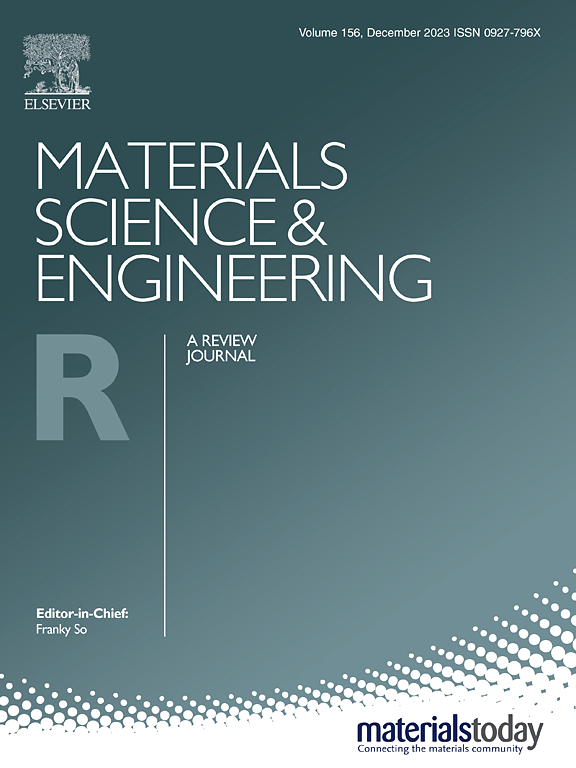Ti3CN MXenes-induced N-N couplings modifies perylene-diimide-based cathode interlayers for 20 % efficiency organic solar cells
IF 31.6
1区 材料科学
Q1 MATERIALS SCIENCE, MULTIDISCIPLINARY
引用次数: 0
Abstract
The perylene-diimides-based cathode interlayers exhibit unique properties, such as optimal energy levels, strong electron affinities, and insensitivity to film thickness. However, the inherent aggregation features of these molecules result in uneven film surfaces that are difficult to avoid, potentially impairing the devices’ performance. Herein, we propose the N-N couplings strategy for improving the charge extraction ability in the cathode interlayers in organic solar cells by incorporating nitrogen functionalities Ti3CN with the representative cathode materials, PDIN and PDINN. Upon introducing 1 % Ti3CN by weight into PDIN, The Ti within the Ti3CN structure acts as an electron donor, losing electrons to generate a positive charge that attracts the amino end groups of PDIN, leading to N-N couplings. The N-N interactions resulted in a smoother layered surface and enhanced conductivity of the cathode interlayer, thereby increasing the charge extraction property. When these layers were applied in devices comprising PM6 and Y6 derivatives, the dark current leakage was suppressed, and charge extraction processes were optimized, leading to enhanced short-circuit current density and fill factor, thus, an optimum power conversion efficiency of 20.0 %. Our findings on the N-N couplings strategy offer valuable insights into developing hybrid cathode interlayers for highly efficient organic solar cells.
Ti3CN mxenes诱导的N-N耦合修饰了效率为20% %的有机太阳能电池的苝-二亚胺基阴极中间层
基于苝-二亚胺的阴极中间层具有独特的性能,如最佳能级、强电子亲和和对薄膜厚度不敏感。然而,这些分子固有的聚集特性导致薄膜表面不均匀,难以避免,潜在地损害了器件的性能。在此,我们提出了N-N耦合策略,通过将氮官能团Ti3CN与具有代表性的正极材料PDIN和PDINN结合,来提高有机太阳能电池正极夹层的电荷提取能力。在PDIN中引入重量为1 %的Ti3CN后,Ti3CN结构中的Ti充当电子供体,失去电子产生正电荷,吸引PDIN的氨基基团,导致N-N偶联。N-N相互作用使阴极层间表面更光滑,电导率提高,从而提高了电荷提取性能。当这些层应用于含有PM6和Y6衍生物的器件时,抑制了暗电流泄漏,优化了电荷提取工艺,提高了短路电流密度和填充系数,从而使功率转换效率达到20.0 %。我们关于N-N耦合策略的研究结果为开发用于高效有机太阳能电池的杂化阴极夹层提供了有价值的见解。
本文章由计算机程序翻译,如有差异,请以英文原文为准。
求助全文
约1分钟内获得全文
求助全文
来源期刊

Materials Science and Engineering: R: Reports
工程技术-材料科学:综合
CiteScore
60.50
自引率
0.30%
发文量
19
审稿时长
34 days
期刊介绍:
Materials Science & Engineering R: Reports is a journal that covers a wide range of topics in the field of materials science and engineering. It publishes both experimental and theoretical research papers, providing background information and critical assessments on various topics. The journal aims to publish high-quality and novel research papers and reviews.
The subject areas covered by the journal include Materials Science (General), Electronic Materials, Optical Materials, and Magnetic Materials. In addition to regular issues, the journal also publishes special issues on key themes in the field of materials science, including Energy Materials, Materials for Health, Materials Discovery, Innovation for High Value Manufacturing, and Sustainable Materials development.
 求助内容:
求助内容: 应助结果提醒方式:
应助结果提醒方式:


